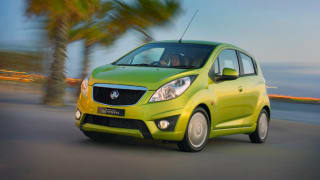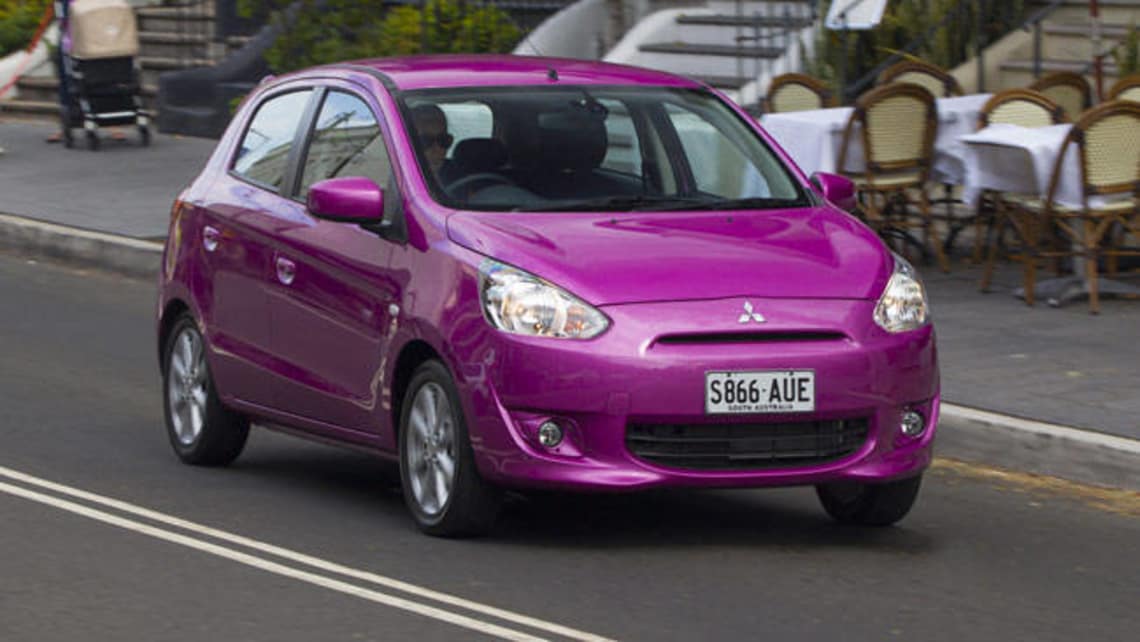
Holden Barina Spark 2011 review
I was ready to spend the next 600 words bagging out this car. But then the boss (she who must be...
Browse over 9,000 car reviews

Mitsubishi Mirage was a major player in the small car scene in Australia during the 1970s and into the ‘80s. Indeed it was built in Adelaide for much of its time on sale here. Mirage faded from the local scene when the local branch of the giant Japanese company got into financial strife and closed its factories, but has now reappeared.
The new Mirage has a price list beginning at a very low $12,990, plus on-roads, and takes on the established Suzuki Alto, Nissan Micra and Holden Barina in the cheap and cheerful class.
Mirage has a modern youthful face with its wide-eyed headlamps and curvaceous bonnet. The narrow grille opening and front bumper acts as an air dam at its corners to ensure optimum airflow around the front, while a roof-mounted rear spoiler also plays a part in improving aerodynamics.
The Mirage has a respectable co-efficient of friction of 0.31, something that’s not easy to achieve in a car of this diminutive size.
The sixth generation Mitsubishi Mirage comes from Thailand and is sold in Australia in three specification levels: Mirage ES, ES Sport and LS.
Interior styling of the Mirage LS that we have been testing over the past week features a glossy piano black centre panel adding a premium quality. Silver accents enhance the gearshift panel, gear knob and air-conditioning vents along with chrome door handles, while seats are clothed in a soft, waffle-weave fabric in black and purple.
For a small car, 3710 mm long, 1665 mm wide and 1500 mm tall, headroom and rear legroom are impressive. A tight turning circle of 9.2 metres makes the Mirage nicely manoeuvrable in squeezy parking spots. All-round driver visibility is excellent thanks to a low belt-line.
Our Mirage swallowed a week’s grocery shopping with ease, and with the rear seatback folded, three 20 kilogram bags of chook food.
All variants come with CD player, two speakers, USB and AUX input. The LS, has two additional speakers plus climate control air-conditioning. There’s the convenience of automatic headlamps, rain-sensing wipers and keyless operation with push-button engine starting.
A five-star safety rating for the Mirage has been achieved thanks to the use of Mitsubishi’s RISE body design which provides an impact-absorbing front end in addition to a rigid cabin structure with extensive use of high-tensile steel.
Standard equipment includes six airbags (driver and front passenger, side and curtain), ABS anti-skid braking with Electronic Brake force Distribution and Active Stability Control which works to maintain stability and prevent loss of control while cornering.
The front seats with adjustable head rests have been designed to reduce whiplash injury in a rear-end crash.
Front bumper, headlamps, bonnet and fenders are of an energy-absorbing design to minimise leg injuries to pedestrians in a collision. The energy-absorbing cowl top and wipers are designed to reduce pedestrian head injury.
The 1.2-litre three-cylinder engine uses a variable valve timing system that matches intake valve timing to engine speed and load to squeeze out 57 kW of power at 6000 rpm and maximum torque of 100 Nm at 4000 revs. The willing little powerplant is mated to either a five-speed manual or an efficient CVT automatic.
The CVT in our test vehicle had the three-cylinder engine sounding a bit rough around the edges. You can choose to find that irritating, or call it character. We plumped for the latter and really enjoyed the sound and feel of this cheerful little machine.
On the road the Mirage has a similarly happy feeling, refinement is pretty good, all the more so when you take into account the very low price.
Handling is safe and secure though not what you call sporting. At the highest speeds likely to be attempted by most owners there’s plenty in reserve, with understeer that comes in as the limit approaches to scrub speed off.
Ride is good on all but the roughest of roads, where the Mirage tends to get bumped about a fair bit. As a suburban car it’s more than adequate, though we wouldn't really suggest it for prolonged country trips.
Typical fuel consumption will be in the five to six litres per hundred kilometre range in country driving, and seven to nine litres in tough commuting.
| Vehicle | Specs | Price* | |
|---|---|---|---|
| ES | 1.2L, —, CVT AUTO | $4,510 – 6,600 | 2013 Mitsubishi Mirage 2013 ES Pricing and Specs |
| Sport | 1.2L, —, CVT AUTO | $4,840 – 7,040 | 2013 Mitsubishi Mirage 2013 Sport Pricing and Specs |
| LS | 1.2L, —, 5 SP MAN | $4,290 – 6,380 | 2013 Mitsubishi Mirage 2013 LS Pricing and Specs |
| LS Pop Green Plus Pack | 1.2L, —, CVT AUTO | $5,830 – 8,250 | 2013 Mitsubishi Mirage 2013 LS Pop Green Plus Pack Pricing and Specs |
$2,750
Lowest price, based on 70 car listings in the last 6 months